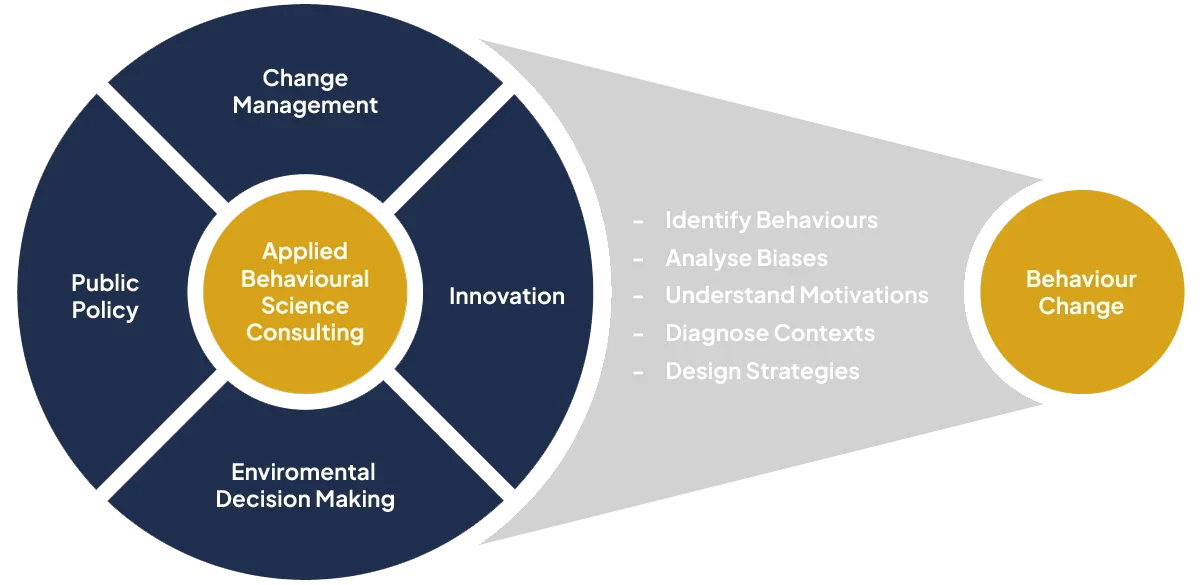Behaviour Change Consulting
Behaviour change consulting bridges the gap between research and real-world applications. It helps decision makers and practitioners use behavioural scientific insights to create lasting positive changes in people’s behaviour.
Behaviour change consulting can boost organisational culture and team performance, and informs public policy design.

We Offer Advice for Organisations
Our consulting services help organisations use behavioural science to improve decision leadership, boost workplace engagement, and drive cultural change. We partner with key stakeholders and leaders to identify team dynamics and improve organisational behaviours.
Behavioural change management is a smart way to use behavioural science to guide how people behave and act in organisations. It helps influence how individuals or groups behave. The ultimate goal is to drive specific organisational, civic, or personal processes of transformation and change.
We Inform Public Policy
We use the latest findings in behavioural science to create effective policy solutions. The goal is to shape public policies on critical social issues, including the environment, energy, and public health.
The behavioural approach to policy making considers how people’s decisions are influenced by cognitive biases and the use of intuitive rules of thumb (heuristics). By understanding these biases and heuristics, policy can be designed to better reflect how people really behave.
Our Consulting Expertise

1. Behavioural Change Management
Behavioural change management applies behavioural science principles to improve organisation development and decision leadership.
It helps comprehend and shape individual or group behaviours using proven human-centred strategies to propel positive transformations in organisations, society, or personal lives.
Read more about behavioural change management.
2. Behavioural Innovation
Applying behavioural science boosts innovation in organisations. We add behavioural design thinking to innovation processes and help practitioners use behavioural science to shape the organisational environment for innovation.
By tapping into psychology, we uncover what drives people to innovate and how biases and social interactions affect the innovation process. Spotting cognitive biases, mental decision shortcuts, and framing effects helps lower the perception of risks.
For example, adjusting how risks and rewards are presented influences people’s decisions. Understanding how these influences shape choices to innovate helps us create strategies to decrease the perceived risks in innovative endeavours.
Read more about behavioural innovation.
3. Pro-Environmental Behaviour
By using behavioural design strategies like nudging and habit formation, we can seamlessly make green practices a part of our everyday lives. These frameworks and techniques bridge the gap between environmental awareness and taking eco-friendly actions.
By blending insights from environmental psychology with practical behavioural design methods, we create powerful ways to encourage green behaviours in daily routines and contexts.
Read more about green behaviour shift with behavioural science.
4. Behavioural Public Policy
In Nudge: Improving Decisions About Health, Wealth, and Happiness, Thaler and Sunstein introduced a captivating concept: Behavioural public policy. This approach is not grounded in assumptions about how people should behave according to standard economic theories, but rather uses insights from behavioural science to craft policies to steer people towards positive choices, based on evidence how they really behave.
Instead of relying on strict rules, behavioural public policy gently guides behaviour through nudging, social cues, and clever choice architecture. By grasping cognitive biases, shortcuts in thinking, and social influences, behavioural public policy is based on smarter people-focused strategies that lead to better outcomes.
Read more about the foundations of behavioural public policy.
For further details on the concepts guiding us in translating behavioural science into actionable advice refer to our White Paper.
